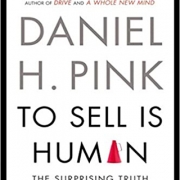The E Test for Blogs
Since the 1980s, Daniel Pink lets us know in his book To Sell is Human: the Surprising Truth About Moving Others, psychologists have used the E test to measure “perspective-taking”. Asked to, with the index finger of their dominant hand, draw the letter E on their own forehead, some will draw the letter “backwards” (so that they themselves can read it), while others will draw the E correctly, with the spokes to the right, (so that others can read it). When confronted with an unusual or complex situation, will that person examine it from only his/her own point of view, or step outside and view the situation from another’s perspective? What’s being tested is the ability to “attune”, bringing one’s own outlook into harmony with other people. When it comes to sales, there’s an important additional element in attunement, the author goes on to explain. Individuals don’t exist as single units; their reactions are connected to groups, situations, and contexts.
When it comes to blog marketing, achieving “attunement’ is all about finding the right timing, along with the right context. Back in 2009, with Say It For You in only its second year, I shared an insight gained from the late advertising marketing guru Eugene Schwartz: As the same promise is made over and over by different providers, the market progresses to a new level of sophistication, and it becomes necessary to market through unique value propositions. And, as prospects achieve the highest levels of sophistication, Schwarts went on to say, marketers must use prospect-centered tactic (AKA attunement).
Blog marketing itself, of course, is inherently prospect-centered – the only people who are going to notice your blog posts are those who are searching for the kinds of information, products, or services that relate to what you do. Having said that, it’s still crucial to keep your blog posts “attuned” to the frequency and sophistication level of your target audience, not to mention to those of the others in their “context”.
As content writers, we need to ask ourselves – would our blog posts pass the E test?







Follow us online!